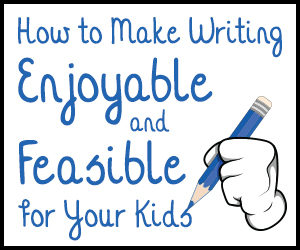
Do your children cringe at composition time?
Do they say “I can’t” when it comes to putting pencil to paper?
Believe it or not, it is possible to make writing enjoyable and feasible for your children. In fact, with some helpful knowledge about learning and the right writing projects, you may see your kids crack a smile when they write!
I have some tips below on how you can make writing easier and more enjoyable for your kids. I hope they turn your composition time into a blessing for your and your children!
Ways to Make Writing Enjoyable and Doable for Your Kids
The Project Should Match Their Ability Level
First and foremost, know that if you ask a child to write something that is well above his ability, you will create frustration. I saw this clearly when I subbed for a first grade classroom in a public school. One of the assignments for the day was to write a report about one of Ben Franklin’s inventions. Needless to say, the kids struggled with this assignment. I did my best to make it easier for them, but expecting children of this age level to write a report is very unreasonable. So when choosing writing assignments for your kids, keep reading and writing abilities in mind. While it is okay to challenge your children a little sometimes, you want to be careful that you don’t give them a project that is overwhelming.
Provide Your Children with Good Literature
Children learn by example. That’s why it is so important for you to expose your children to good literature by a variety of writers. The authors of these works will act as role models for your children.
Use Models
Before beginning any writing project, it is important to share models of that type of writing first. Children learn by looking at and copying examples. That’s why I believe copy work is so valuable. Regularly copying work of a specific genre will train the child’s brain in writing in that genre. That’s why I created copy work pages of a variety of writing genres including nonsense verse, riddles, limericks, and tongue twisters. They provide models for your children to use.
Use Patterns
Some children need a pattern to use before attempting to create their own work. With a pattern, they need only insert words and phrases into a framework. Here’s an example of a pattern for the song “Aiken Drum.”
There was a man lived in the (place) ,
and his name was (name) .
And he played upon a (thing)
and his name was (same name) .
The children copy the pattern and insert their own words. They have the opportunity to use a little creativity while having a structure to build their writing on. This method is excellent for beginning writers. It also serves as a building block towards learning how to write a piece entirely on their own.
Offer Fun Writing Projects
While it’s important for kids and teens to be able to write good reports, they aren’t the only type of writing that exists. There are plenty of fun writing projects like tongue twisters, poetry, plays, song lyrics, stories, prayers, and “how to” articles that they can write. If you’re looking for inspiration, I have a list of creative writing projects here and a list of practical writing projects here. I also have a list of writing projects that you can do as a family here.
Variety is the Spice of Life
Children will get bored if they have to do the same kind of writing day in and day out. You can make writing a lot more fun if you offer a variety of writing projects. This is also a good way to determine if your child has a talent for a certain type of writing. You may have a poet and don’t know it in your homeschool. 
Offer Choices
Choices are a motivating factor. A child will be more enthusiastic about writing something that he chooses rather than something that he is assigned. While there are times when you will have to require your child to write a certain project for the sake of teaching him a skill, offering choices at other times will soften the blow a bit. After all, in the real world, there are times when we are required to write certain types of compositions, but there are also other times when we have the freedom to choose what we write.
Throw in Some Randomness
Now and again, it can be fun to throw a little chance into your day. It can make for some interesting and humorous writing. In my post about fun sentence writing activities, I describe an activity where you pull random words out of containers to build a sentence. You could do something similar with writing projects. You might try putting some writing prompts into a jar and have your child pull one out every Friday. If you’re looking for some writing prompts, I have some fun thematic ones here.
Let Your Child Use a Computer
Some kids find typing on a computer more fun than physically writing. While I believe that handwriting is not (and shouldn’t be) a lost art, I do think that computers can be effective tools for writing some compositions. Long projects like stories and reports are probably best done on a PC because it enables the child to easily add, delete, and move around text.
Give Plenty of Positives
A child takes a chance every time he sits down to write something. He doesn’t know whether his writing will be approved of. That’s why it’s so important to praise and encourage every step he takes in writing. If you bring a smile and enthusiasm to your homeschool writing class, your kids will catch on to that and enjoy writing.
If you’re looking for tools that will make writing easier for you kids, check out the Language Arts section of my publishing company. It has fun writing prompts, resource pages with helpful lists, copy work in a variety of genres, and more!






